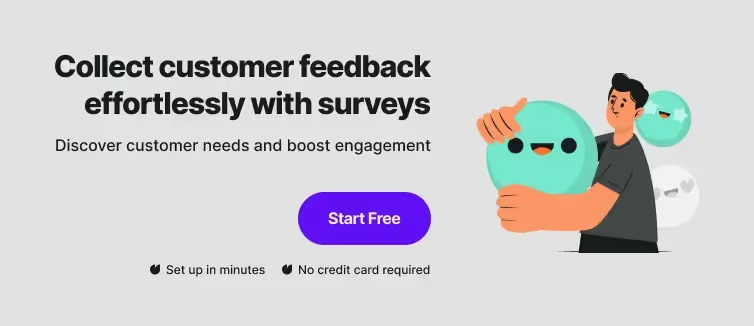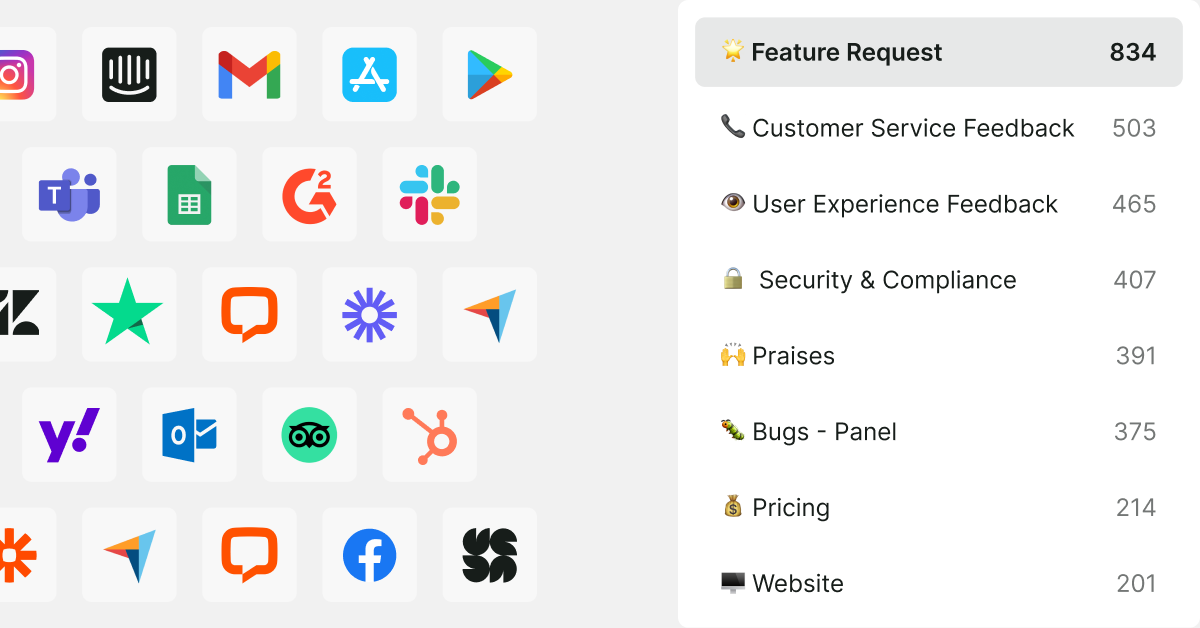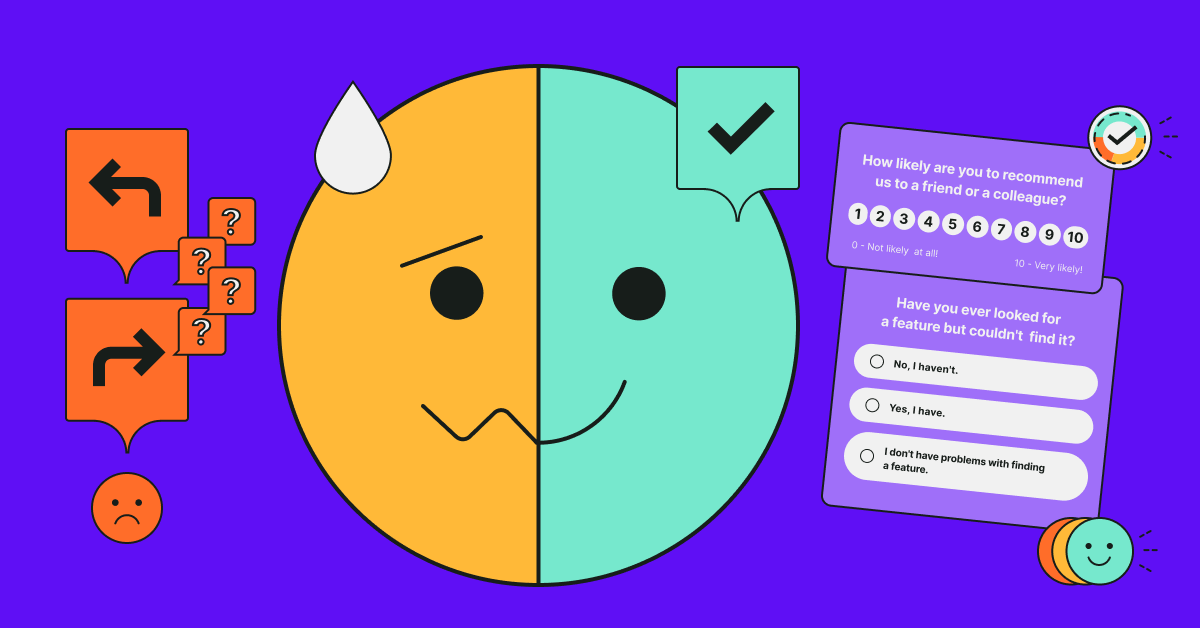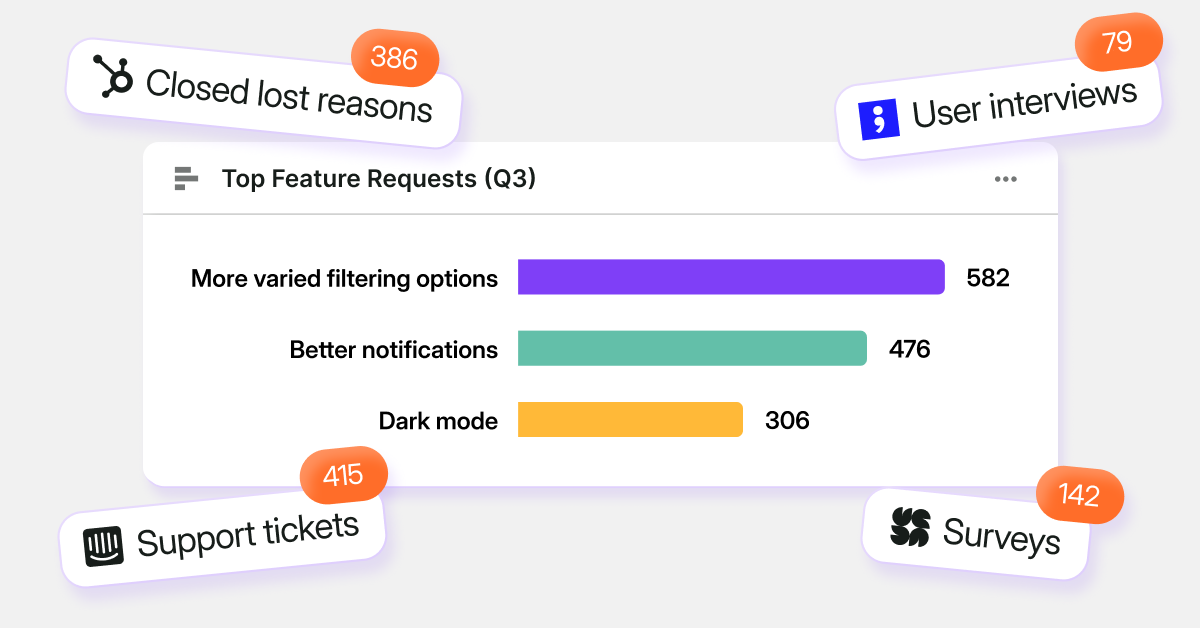Tl;dr;
- Customer surveys: Survey tools such as Survicate are essential for conducting quantitative and qualitative research across various customer touchpoints and improving digital CX
- Diverse research methods: Employ a mix of customer research methods like different types of surveys, interviews, focus groups, observational studies, and usability testing to gain comprehensive insights into customer behavior and product interaction.
- Importance of continuous feedback: Establishing feedback loop mechanisms is crucial for ongoing improvement, ensuring that products and services evolve in response to customer needs.
- Data analysis: Systematic data collection followed by thorough analysis using appropriate customer research tools is key to identifying trends and making informed decisions.
- Actionable feedback: Prioritize and strategize based on research findings to create actionable insights that drive measurable improvements in customer experience management and business processes.

Cutting through the chatter to hear your customers' true opinions is no small feat.
Tailored for business owners and marketers, this article zeroes in on how to conduct customer research. We'll highlight the strategies that directly connect you to your audience's preferences and pain points. By tapping into these insights, you'll be equipped to make informed, impactful business decisions.
Dive in to transform customer feedback into a clear direction for your brand's growth and success.
What is customer research?
Customer research is an essential practice focused on collecting data about your customers to understand their characteristics, needs, and behaviors.
Why is customer research important?
- Informed Decision-Making: You gain actionable insights into customer preferences and satisfaction, empowering you to make data-driven decisions.
- Enhanced Customer Experience: Understanding what your customers value guides your efforts to improve their experiences with your product or service.
- Strategic Focus: Tailoring your business strategy becomes more focused as you identify key demographics and market segments.
- Product Development: Product features and improvements align better with customer expectations when informed by customer research.
- Competitive Edge: Detailed knowledge about your customers can give you a competitive advantage by identifying opportunities and gaps in the market.
Customer research vs. market research
Customer research and market research serve distinct purposes in understanding buyers and the competitive environment.
Customer research dives deep into your existing or potential customers' behaviors, needs, and preferences. It aims to create a detailed understanding of the customer journey, from awareness to purchase and is often qualitative in nature.
On the other hand, market research takes a broader approach, examining the market as a whole, including industry trends, competitor analysis, and market share.
While customer research is about the 'who' and 'why' behind purchasing decisions, conducting market research addresses the 'what' and 'how' of market conditions and opportunities.
Both types of research are crucial for informed decision-making but focus on different aspects of the business landscape. Customer research is about improving the customer experience and tailoring products or services to consumer needs. Market research is about understanding the market landscape to strategize and position offerings effectively.
Primary research vs. secondary research
In customer research, understanding the distinction between primary research and secondary research is crucial for choosing the right approach to obtain your insights.
Primary research
Primary research involves collecting data firsthand for your specific research goal. This data is original and gathered through methods directly controlled by you. Examples include:
- Surveys and questionnaires: Deploying custom surveys to collect customer feedback on a new product or service.
- Interviews: Conducting one-on-one dialogues to dive deep into customer opinions and experiences.
- Focus groups: Facilitated group discussions to obtain a range of perspectives on a particular topic.
Secondary research
Secondary research methods rely on data previously collected by others. It's an evaluation of existing information that may include:
- Industry Reports: Analyzing market research findings related to your sector.
- Academic Journals: Reviewing studies and papers for trends and outcomes that align with your interests.
- Market Analysis: Assessing competitor data and market summaries to inform your strategies.
Types of customer data
Before diving into specific categories, understand that customer data is essential to personalize your marketing strategies and enhance customer experiences. This data comes in two core types: qualitative and quantitative.
Qualitative data
Qualitative research gathers non-numeric information that captures your customers' opinions, motivations, and attitudes. This data often comes from:
- Interviews, direct conversations that provide in-depth insights.
- Open-ended survey responses allow customers to express their thoughts in their own words.
Quantitative data
Quantitative research collects numerical data and can be measured and analyzed statistically. Key sources include:
- Transaction records: Sales data showing purchasing patterns.
- Website analytics: Metrics like page views and click-through rates representing user behavior.
Best customer research methods
When conducting customer research, you need to select the right methodology to gain valuable insights. Various research methods cater to different needs, from understanding user behavior to gauging customer satisfaction.
Customer surveys and questionnaires
Deploy online surveys and questionnaires to quickly gather quantitative and qualitative data from a large audience. For example, a survey tool such as Survicate offers a variety of different distribution channels:
Surveys are a cost-effective way to gather market research insights from the entire customer digital journey. If you use them as a part of a feedback loop, they can help you improve the CX considerably.
widely via email, websites, or social media platforms. Ensure your questions are direct and easy to understand to maximize response rates.
Interviews
Conduct interviews to collect in-depth qualitative data. One-on-one interviews allow for a deep dive into customer opinions, beliefs, and experiences. Record these sessions, if possible, to ensure that none of the details are lost.
Focus groups
Utilize focus groups to explore customer attitudes and behaviors in a group setting. This method sparks conversation and can uncover insights that might not surface in one-on-one interactions. Be wary of group dynamics such as conformity, which can influence individual responses.
Observational studies
Observational studies involve watching how users interact with your product in their natural environment. This method provides unfiltered, real-world user behavior that can be invaluable in understanding how your product is used.
Usability testing
Usability testing is imperative for evaluating the functionality and design of your product. Recruit participants to complete specific tasks while observers note where they encounter issues or experience confusion.
Field trials
Conduct field trials by providing users a prototype or beta version of your product for a certain period. This hands-on approach yields feedback on your product's performance in real-life scenarios.
Review mining
Lastly, review mining involves analyzing customer feedback found in online reviews and forums. This passive method is particularly useful for identifying common pain points and areas for improvement without the need for direct interaction.
Types of customer research
Customer research encompasses various methodologies aimed at understanding your market and clientele. Tailoring these approaches helps you stay informed and make data-driven decisions.
Competitive research
You analyze your competitors to benchmark your products, services, and customer satisfaction levels against them. This helps in identifying industry standards and areas for improvement.
Customer journey mapping
Journey mapping involves charting the steps your customers take, from discovering your brand to making a purchase and beyond. It's a strategic approach to understanding customer interactions with your brand.
Buyer persona research
You create detailed profiles of your typical customers based on demographic and psychographic data. These personas help in crafting targeted marketing strategies.
Customer experience research
You assess customers' overall experience with your brand, from the usability of your website to customer service interactions, to optimize every touchpoint.
Customer segmentation research
Market segmentation divides your customer base into distinct groups based on common characteristics to provide more personalized products and services.
Customer needs research
You investigate your customers' underlying needs and desires to develop products that solve specific problems or enhance their lives.
Customer satisfaction research
You measure how your products and services meet, exceed, or fall short of customer expectations, often using surveys, feedback forms, and follow-up interviews.
Pricing research
You evaluate customers' responses to pricing changes and their perception of your product's value to establish an optimal pricing strategy.
Brand perception research
You gauge how customers perceive your brand to ensure your messaging aligns with their beliefs and your company values.
Designing a research plan
Precision and structure are pivotal for gathering actionable insights in constructing a customer research plan. These steps will guide you through creating an effective framework for your research efforts.
Set objectives
Identify what you want to achieve with your research. For instance, you may aim to understand customer satisfaction, identify buying patterns, or test product concepts. These objectives should be Specific, Measurable, Achievable, Relevant, and Time-bound (SMART) to ensure clarity and focus.
Identify target audience
Determine who your customers are by segmenting the market. To accurately represent your overall market, include demographics, psychographics, and behaviors in your segmentation. Knowing your audience can tailor your research to yield more relevant data.
Recruit participants
Once you know who to target, select participants who best represent your customer base. Employ strategies such as customer databases, social media outreach, or third-party panels to gather a varied group that reflects your target audience's diversity.
Choose appropriate methods
Your objectives will dictate the methods you choose. Qualitative approaches like interviews afford depth, while quantitative methods like surveys provide breadth. Select the right blend of methods to gain a multidimensional view of customer sentiments.
Sampling techniques
Employ sampling techniques to generalize your findings. Random sampling ensures everyone has an equal chance of selection, while stratified sampling involves dividing your audience into subgroups and sampling from these categories to ensure all segments are represented.
Build a continuous process with feedback loops
Establish ongoing mechanisms to capture customer feedback regularly. This could involve periodic surveys or real-time feedback systems. Make sure you continuously iterate your product or service based on this input, creating a virtuous cycle of improvement.
Data collection and analysis
Effective customer research hinges on the systematic collection and meticulous analysis of data to decipher patterns, understand behaviors, and make informed decisions.
Gather data systematically and analyze it to uncover patterns and trends. Use analytical tools that can handle your data type and amount. Look for relationships between variables and compare these findings against your goals.
Quantitative data analysis
You'll handle numerical data that can be measured and compared in a straightforward manner. Quantitative analysis often employs statistical tools to interpret data sets and deduce meaningful insights. Common techniques include:
- Descriptive Statistics: Summarize your data through means, medians, and modes.
- Inferential Statistics: Make predictions and infer trends from your sample data.
- Regression Analysis: Determine the relationship between variables.
Qualitative data assessment
With qualitative data, your focus is on interpretative analysis of non-numerical information, such as customer interviews or open-ended survey responses. Key approaches involve:
- Thematic Analysis: Identify patterns or themes within qualitative data.
- Content Analysis: Categorize text to understand the frequency and relationships of words or concepts.
- Narrative Analysis: Explore the structure and content of stories to gain insights into customer perspectives.
Mixing methods
Combining quantitative and qualitative analysis can provide a holistic view of your customer research. Employ a 'mixed methods' strategy to:
- Validate findings across different data types.
- Gain a richer, more nuanced understanding of research questions.
- Balance the depth of qualitative assessment with the generalizability of quantitative analysis.
Interpreting and reporting results
Turn your data into action by using insights to inform business decisions. Whether it is refining product features or adjusting marketing strategies, use the research to create value for your customers and your business.
Drawing conclusions
When you are ready to draw conclusions from your customer research, begin by assessing the data's significance. Look for patterns and trends in the feedback and quantifiable data. Tabulate your findings when possible, as this makes comparisons clearer:
- Quantitative Data: Calculate averages, frequencies, and percentages. A table showing the response distribution for each question can clarify these statistics.
- Qualitative Data: Group feedback into themes. For instance, list common descriptors used by customers when discussing a product feature.
Conclusions should directly relate to the research objectives you set before the study.
Creating actionable insights
After drawing conclusions, it's crucial to translate them into actionable insights:
- Prioritize: Determine which findings substantially impact your objectives or pose the biggest challenge to your CX.
- Strategize: For each priority area, brainstorm potential strategies. This may involve a simple list or a SWOT analysis (Strengths, Weaknesses, Opportunities, Threats) for complex decisions.
Always ensure that your insights are actionable; they should inform decisions and lead to measurable improvement in consumer experience or business processes. Communicate these insights with clear, straightforward language to the relevant stakeholders in your organization.
Emerging trends in customer research
Conduct market research with AI
Customer research is adapting to leverage cutting-edge technologies. You'll notice a significant shift towards harnessing data analytics and artificial intelligence (AI) to derive deeper insights into customer behavior.
You can leverage Survciate AI-powered features as well. Try the AI survey creator that will design your customer or market research survey in under a minute after you describe your needs and objectives.
After you collect feedback, you can use the AI Topics feature to speed up getting qualitative insights. It will automatically categorize and summarize answers to your open-ended questions. Worth trying, isn't it?

Social listening
Social listening tools are another trend on the rise. They enable you to monitor your brand's social media presence and gather direct feedback from conversations about your products or services. Mobile ethnography also offers a way to observe customer interactions in a natural setting, providing contextually rich data.
Predicting customer behavior
Lastly, as the emphasis on personalization grows, predictive analytics are being adopted to tailor customer experiences. These techniques analyze past behavior to anticipate future needs, enhancing your ability to meet customer expectations preemptively.
Remember, these methods involve collecting various forms of customer data, so being vigilant about privacy and ethical data use is crucial. Follow regulations and best practices to ethically manage the information you gather.
Survicate for your market and customer research
As we've explored, the key to thriving in the current market is to truly understand your customers. The challenge, however, lies in efficiently gathering and interpreting their feedback to inform your business strategies.
With its user-friendly interface, Survicate allows you to create targeted surveys, collect real-time feedback, and analyze the data with ease, ensuring that every customer voice is heard and accounted for.
Survicate's suite of features simplifies the process of connecting with customers and extracting the insights you need to make data-driven decisions. Whether it's through NPS, customer satisfaction surveys, or user experience research, Survicate provides the clarity and direction required to adapt and excel in a fast-paced market.
For those ready to elevate their customer research, consider giving Survicate a try. Start your journey to clearer insights today with a free 10-day trial of the Business Plan, and experience the full potential of focused customer feedback. Take the step today, and transform the way you connect with your audience.














.svg)

.svg)



